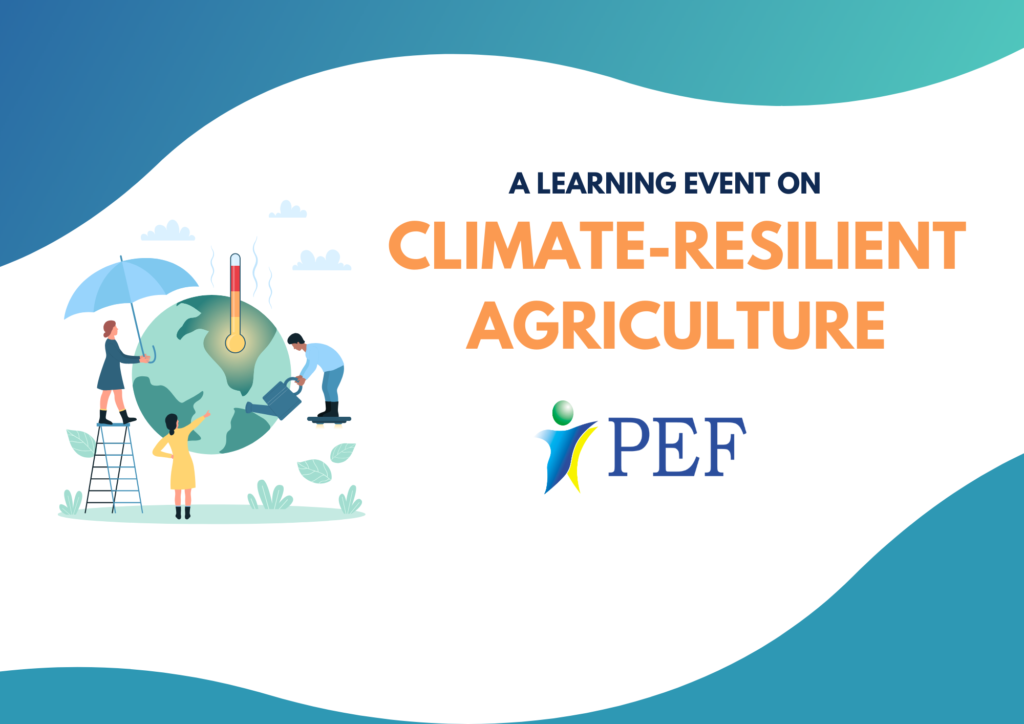
Strengthening climate resilience in agriculture
The effects of climate change continue to impact health and food security. Storms, droughts, and floods are causing extensive damage to infrastructure and livelihood. With the Philippines as one of the countries most affected by climate-related disasters, information campaigns are necessary to help the vulnerable sectors, including farmers and fisherfolks.
In a learning session (#PEFTalks) held on March 5, 2024, representatives from the Department of Agriculture Climate Resilient Agriculture Office (DA-CRA) and the International Institute for Rural Reconstruction (IIRR) shared their insights and experiences on climate resilient agriculture, particularly ways to mitigate climate change effects on farms and fisheries.
Outsmarting climate change
Mr. Zelzo M. Dela Cruz, Planning Development Officer of DA-CRA, explained that climate change is already showing its destructive effect on farming, pushing farmers and fisherfolk to poverty and food insecurity.
Dela Cruz cited that climate hazards such as typhoons, droughts, and even pests and diseases contributed to almost Php 300 billion in damage to agriculture from 2013 to 2022, with rice as the most damaged crop in these events.
“To help our farmers and fisherfolks, the DA created the AMIA program to make their livelihoods resilient to climate and economic shocks,” he said.
The AMIA, or Adaptation and Mitigation Initiative in Agriculture Program, aims to promote climate-resilient agriculture technologies and practices to empower communities to manage climate risks while pursuing sustainable livelihoods; and while delivering integrated and
tailor-fitted support services the most affected by climate change.
All over the country, DA has created AMIA villages where farmers are given appropriate tools and technologies that can help them manage climate risks in farmlands and fisheries.
“Our goal is to create food sufficiency to reduce poverty, and address climate change,” Dela Cruz said.
[Know more about AMIA: https://amia.da.gov.ph/]
Learning the best practices in CRA
Meanwhile, IIRR Senior Adviser Dr. Julian Gonsalves shared ways to enable food security and livelihood resilience despite climate change.
“We need to have anticipatory climate change adaptation. We need to plant more trees and diversify our agriculture,” he said.
Gonsalves highlighted diversification as a vital strategy for CRA. These include planting fruit trees, tuber crops, fish ponds, and livestock for multiple sources of food and income.
He also provided tips on fertilizer application, nutrient and soil management, and promoting native livestock.
[Know more about CRA here: https://iirr.org/climate-change-adaptation/]
CRA to be integrated in PEF programs
According to Deputy Executive Director Cauchie Garcia, the insights gained from the learning session will help PEF create appropriate programs to address climate resilience in its focus areas.
“We hope to be more responsive regarding our programming to help enterprises and communities adapt to climate change. We also like to minimize the adverse environmental impact of our projects,” she said.
#PEFtalks are online knowledge events, gathering fresh perspectives, expert advice and innovative solutions on real-time issues and events that will help PEF and its stakeholders in charting directions and designing interventions on the ground.